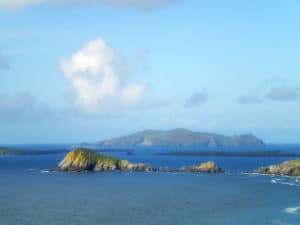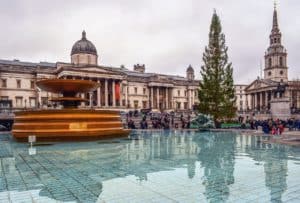The Sámi People: Europe’s Northernmost Indigenous Culture Beyond the Arctic Circle

Updated On: April 23, 2024 by Raghda Elsabbagh
The Sámi people are an indigenous group with a rich cultural heritage that transcends the borders of the Arctic Circle. Their ancestral lands, known as Sápmi, cover the northern regions of Norway, Sweden, Finland, and Russia’s Kola Peninsula. As the original inhabitants of these areas, the Sámi have a deep connection to the environment, which is marked by a traditional lifestyle that is closely tied to the land, the seasons, and the reindeer that are central to their livelihood and culture.

Over the years, the Sámi have maintained their distinct languages, traditional clothing, handicrafts, and music, all of which reflect a vibrant culture that has adapted over time while retaining its unique identity. Despite facing numerous challenges, including issues of land rights and cultural preservation, the Sámi people continue to strive for recognition and protection of their way of life. Today, they stand as a testament to the endurance and resilience of indigenous cultures in the modern world, balancing the preservation of their heritage with the influences of contemporary society.
Table of Contents
Historical Overview of the Sámi People
Our exploration of the Sámi people’s past reveals a rich tapestry of survival and adaptation beyond the Arctic Circle. Their long-standing traditions and distinctive way of life offer insights into human resilience and cultural integrity in one of the harshest environments on Earth.
Origins and Early History
The Sámi are believed to have inhabited the northern parts of Fennoscandia for thousands of years. As a Finno-Ugric ethnic group, their origins lie in a common ancestral population with other Uralic peoples. Archaeological evidence indicates their presence in the region since at least 2500 BCE, with their ancient traditions reflecting a deep connection to the land and its resources.
Their society was traditionally nomadic, revolving around a cycle of reindeer herding, fishing, and hunting, which was vital for sustenance in the subarctic and arctic climates. The Sámi language, with multiple dialects, is intricate, having evolved over centuries to encompass the nuanced aspects of their environmental interactions and cultural practices.
Interaction with Viking and Medieval Societies
During the Viking Age and the medieval period, the Sámi were known to have interacted with Norse explorers and traders. These encounters brought the Sámi into the sphere of Scandinavian influence, and while they maintained their autonomy, commodities like fur, walrus ivory, and other goods began to be traded, integrating the Sámi into wider historical networks of commerce and culture.
The Sámi managed to persist with their traditional nomadic lifestyle even as the state boundaries of Sweden, Norway, Finland, and Russia formed around them. However, their culture and autonomy faced challenges as Christianity and later colonial policies sought to assimilate the Sámi and exploit the resources of Sápmi, the area they inhabited. Despite these pressures, the Sámi have maintained their distinct identity and continue to preserve their cultural heritage into the present day.
The Sámi Homelands
As we explore the Arctic expanses, the Sámi homelands emerge as a rich tapestry of culture steeped in tradition and natural beauty. The region is a testament to the resilience of the Sámi people and their adaptation to the arctic climate.
Geographical Distribution
The Sámi, recognised as the northernmost indigenous people of Europe, reside across four countries: Norway, Sweden, Finland, and the Kola Peninsula in Russia. This expansive area traverses a variety of landscapes, from the tundra to dense forests and coastal areas, illustrating the adaptability of the Sámi culture.
- Norway: Here, the Sámi have a significant presence, particularly in the northern regions.
- Sweden & Finland: Together, they share portions of the Sámi areas, with communities extending into their northern sections.
- Russia: The Sámi population extends into the Kola Peninsula, where they continue to practice their ancient customs.
Lapland and Sápmi
Lapland is a term often synonymously used with Sápmi, though traditionally, Sámi refers to the broader cultural region of the Sámi. This distinction is essential to understanding the nuances of Sámi territory:
- Sápmi: Encompasses the entire area across the four countries where the Sámi people have historically roamed and lived.
- Lapland: While also a historical name associated with Sámi territories, it’s often used administratively within certain countries, primarily in Finland and Sweden.
Our journey through the homelands reveals a landscape that is as diverse as it is extreme, with the northern extents experiencing a harsh, subarctic climate that shapes the traditional Sámi ways of life:
- Tundra: Characterises the northernmost parts, where vegetation is sparse, and reindeer herding is prevalent.
- Forest: The boreal or taiga forest zone provides resources like wood and game animals.
- Coast: The coastal areas, notably in Norway, offer rich fishing grounds crucial to Sámi sustenance.
Cultural Significance
The Sámi people boast a rich cultural tapestry woven from their traditional beliefs, language, mythology, and their distinctive arts and handicrafts. Delving into these aspects offers us insight into their profound connection with nature and their resilience in preserving their identity amidst modern challenges.
Traditional Beliefs
Our culture is deeply entwined with a reverence for nature, exemplified by a myriad of spirits that inhabit our surroundings. These spirits are central to the Folklore of the Sámi and play a significant role in our daily lives and practices. We maintain a deep respect for the Northern Lights, or Guovssahas, seeing it as a powerful natural phenomenon with spiritual significance.
Language and Mythology
The Sámi Language is part of the Finno-Ugric language family, encapsulating our rich oral tradition that includes mythology and folklore. Through our stories, we pass down the wisdom of the ancestors, recount sagas of creation, and explain natural phenomena. This longstanding tradition contributes to the cultural understanding and ethereal beauty of our homelands.
Arts and Handicrafts
Duodji, the Sámi word for handicrafts, refers to both the functional and artistic creations we produce using materials like wood, horn, and bone. Embroidery embellishes our traditional dress, the Gakti, which varies in design to reflect one’s geographical area and family. The Gakti is not merely attire; it is a display of identity and pride in our heritage.
Socio-Economic Aspects

As we explore the socio-economic aspects of the Sámi people, we focus on two vital elements of their livelihood: reindeer herding and husbandry, as well as their fishing, farming, and hunting activities. These elements are not only economic practices but also a reflection of their rich cultural heritage and traditional knowledge.
Reindeer Herding and Husbandry
The Sámi are perhaps best known for their deep connection with reindeer herding, a practice that is both a cultural identity and a source of livelihood. Centuries-old expertise in husbandry allows the Sámi to thrive in the demanding Arctic environment. Reindeer are not only a source of meat, fur, and other products but are central to the nomadic lifestyle of the Sámi, especially in the winter months when herds are driven to different grazing grounds, reflecting a well-adapted strategy for survival and economic resilience.
- Winter: Herding practices during the colder months are crucial as herds are moved to winter pastures.
- Summer: In contrast, summer brings with it an abundance of grass in the uplands, allowing for the reindeer to graze and build reserves for the upcoming winter.
Fishing, Farming, and Hunting
Beyond herding, the Sámi also engage in fishing, farming, and hunting. Coastal Sámi communities, in particular, have historically relied upon fishing as a mainstay of their economy, a testament to their adaptability and expertise in utilising the rich aquatic resources of the Arctic Circle. Farming, though limited by the harsh conditions, is practised by some; meanwhile, hunting continues to supplement the traditional diets and provides another layer to the Sámi’s subsistence strategies.
- Fishing: A critical activity, especially during the summer when fish are plentiful.
- Hunting: With traditional knowledge, it is an important supplemental activity to herding and fishing.
- Farming: While not widespread, it is adapted to the challenging Arctic conditions.
The Sámi and the Natural Environment

The Sámi people have a profound connection with nature, intricately bound to the environmental elements of the Arctic region, such as climate, forests, and wildlife. We recognise that their way of life, especially reindeer herding, is deeply influenced by the health of their natural surroundings.
Environmental Challenges
The Sámi are facing numerous environmental challenges that affect their traditional livelihoods. Climate change is rapidly altering the Arctic landscape, directly impacting the integrity of reindeer pastures. Increased temperatures and unpredictable weather patterns result in unstable ice conditions and changes in vegetation, which are crucial for reindeer grazing. As forests in the region confront the influx of logging industries, the Sámi struggle to preserve the biodiversity essential to their culture and subsistence.
Conservation Efforts
In response to these threats, conservation efforts have become central to the Sámi’s agenda to protect their environment. We actively participate in traditional knowledge-sharing platforms to provide insights into sustainable methods of living with nature. Emphasising the need for conservation, the Sámi community works towards maintaining the health of their forests and ensuring the continuity of reindeer pastures. Through collaborative projects with governments and organisations, we seek to combat the detrimental effects of industrial expansion and promote ecological stewardship.
Political and Legal Status

In this section, we explore the complex framework that defines the political and legal standing of the Sámi people within the Arctic region. Our focus is on the recognition of their rights and the role of the Sámi Parliament in both local and international contexts.
Recognition and Rights
Indigenous peoples globally fight for the recognition of their rights, and the Sámi are no exception. They have been acknowledged as an indigenous people, thereby garnering specific minority rights according to international law. This acknowledgement is crucial in supporting their claim to land rights, which is central to preserving their traditional ways of life. Notably, legal recognition has been a turning point for the Sámi’s struggle for autonomy, as seen in policies impacting their communities, but challenges persist, particularly regarding policy-driven recognition threats.
The Sámi Parliament
The Sámi Parliament, established in Norway, Sweden, and Finland, is a notable institutional embodiment of the Sámi’s pursuit of self-governance. Acting as a representative body, this institution aims to strengthen the political position of the Sámi people and foster decision-making closer to the indigenous communities it represents. Although the Sámi Parliament does not have legislative power, its influence is palpable on issues concerning culture, language, and education, among others. With a presence in both national and international arenas, the Parliament is also proactive in Arctic politics and enjoys a relatively strong status as an actor in international politics, particularly within the Arctic region.
Contemporary Life and Communities

In exploring the Sámi people’s present-day existence, we notice a vibrant community adapting to modernity while retaining deep-rooted cultural traditions.
Modern Sámi Society
Community: The Sámi, native to regions in Northern Europe, continue to foster a sense of community through the Siida system—a traditional form of cooperative living. This centuries-old structure supports both the social and economic aspects of Sámi life. Siidas are often the cornerstone for managing reindeer herding, a practice central to Sámi culture, particularly in regions like Finnmark and Trøndelag.
Newspapers: Bolstered by a range of Sámi newspapers, communities are kept informed and connected. These publications serve not just to disseminate news but also to affirm Sámi’s cultural identity and language, proving that traditional media remains relevant in the digital age.
Urbanisation and Cultural Identity
Urbanisation: As many Sámi have moved to urban areas, the challenge of maintaining a unique cultural identity has grown. The Sámi adapt by creating urban siidas and cultural centres to keep their community bonds strong.
Semi-Nomadic: While traditionally semi-nomadic, today’s Sámi have widely embraced stationary lifestyles, with migrations becoming more focused on reindeer herding cycles. Nonetheless, the semi-nomadic spirit continues to influence their societal structures and customs.
In essence, the Sámi people mirror a resilient balancing act, embracing the shifts brought by modernity while continuing to honour and practise their age-old traditions.
Challenges Facing the Sámi People

In this section, we explore the significant obstacles encountered by the Sámi people, which range from ongoing discrimination to the struggle to preserve their rich cultural heritage in the face of modern societal pressures.
Discrimination and Indigenous Rights
The Sámi, Europe’s only Indigenous people, have faced systematic discrimination that undermines their basic human rights. Forced assimilation policies in the past have left deep-rooted impacts that continue to challenge their community. Despite forming their own parliaments to regain control over their cultural affairs and land, the Sámi still confront obstacles in achieving political influence equal to that of the majority populations surrounding their homeland, Sápmi.
Cultural Adaptation and Preservation
Adaptation and cultural preservation pose a dual challenge for the Sámi. As they strive to maintain traditional practices, such as the use of the Lavvo – their traditional tent – changes in the environment and economy necessitate adaptation. For instance, the Inari Sámi, one of the Sámi groups, must balance the modern world with the preservation of their unique forms of singing, known as joiking. Ensuring that their voices are heard and respected within society and that their traditions survive the test of time is an ongoing struggle.
The Sámi in the Modern World
In this section, we’re exploring how the Sámi have carried their rich cultural heritage into the 21st century, affecting both media representation and economic spheres, including tourism.
Cultural Representation and Media
The Sámi people have found new ways to express their culture and assert their presence on the global stage. Dramatic improvements in cultural representation have been ushered in through various channels. Films like Frozen II offered a glimpse into Sámi culture, leading to global recognition of their distinct traditions and contributing to a surge in interest regarding indigenous peoples of the Arctic. Even in mainstream media, there’s been a marked increase in awareness and celebration of Sámi customs and languages. Additionally, we’ve seen Sámi artists and musicians bring their languages and stories to new audiences, contributing to an enriched global tapestry of indigenous expressions.
Tourism and Economic Development
Tourism has emerged as a significant factor in the Sámi’s economic development. Visitors are keen to experience the unique aspects of Sámi life, from reindeer herding to the vivid spectacle of the Northern Lights, which has prompted the development of cultural tourism centred on authentic Sámi experiences. This interest in the region has brought other industries, such as forestry and mining, under scrutiny, striking a balance between economic growth and the preservation of Sámi lands and ways of life.
Balancing traditional livelihoods with new economic opportunities remains a key challenge. As stewards of their land, many Sámi communities continue to negotiate their roles within national economies, often influenced by diverse religious backgrounds such as Lutheran and Russian Orthodox beliefs, as they forge their path in the modern world.
Frequently Asked Questions
In this section, we address some of the most common queries related to the unique characteristics, history, and cultural practices of the Sámi people.
What are the defining physical characteristics of the Sámi people?
The Sámi are often recognised by their distinct physical features, which can include light hair, fair skin, and a robust build adapted to the cold climates of the Arctic region.
Could you outline the history of the Sámi people?
The Sámi have a rich history spanning thousands of years as the indigenous inhabitants of the Sápmi region, which covers parts of Norway, Sweden, Finland, and Russia’s Kola Peninsula.
What are the core elements of Sámi culture?
Sámi culture is deeply intertwined with nature, centred on reindeer herding, fishing, and hunting. Their traditional practices reflect a sustainable lifestyle and a profound respect for the environment.
In which countries can Sámi communities primarily be found?
Sámi communities are primarily found in the northern reaches of Norway, Sweden, and Finland, as well as the northern parts of Russia within the Arctic Circle.
What are some of the traditional customs associated with Sámi heritage?
Traditional customs of the Sámi include their vibrant, colourful clothing called gákti, joik singing, a unique form of music, and numerous festivals that celebrate the changing seasons and key events in Sámi life.
How does the Sámi traditional lifestyle integrate with the Arctic environment?
The traditional Sámi lifestyle is highly adapted to the Arctic environment, with a focus on semi-nomadic reindeer herding that follows the migratory patterns of the animals and utilises the natural resources of the tundra wisely.






